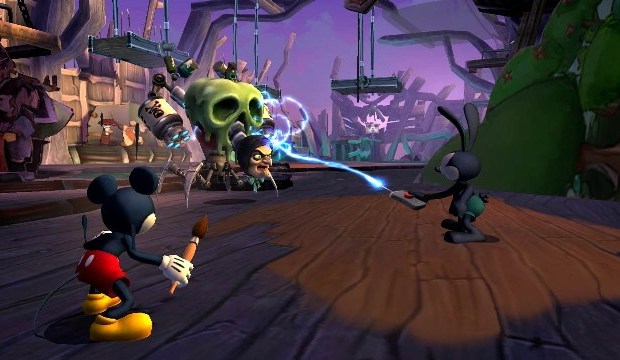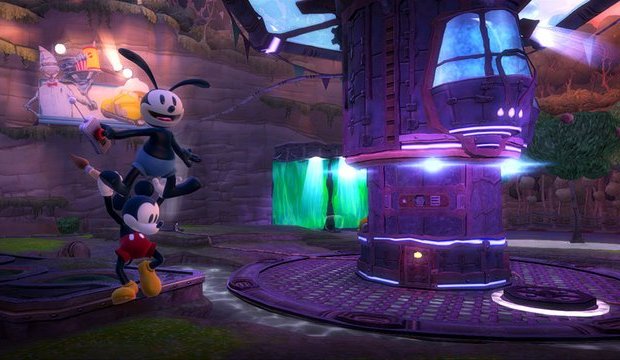Epic Mickey 2: The Power of Two PS Vita Analysis
Warren Spector’s Epic Mickey: The Power of Illusion was a brave and mostly successful attempt to reinvent Disney’s iconic, big-eared mascot into an action hero who would appeal to more than just children. By fusing the twee Disney art style we’ve all come to know with a darker, more intense tone, Power of Illusion took Wii and 3DS owners on an adventure quite unlike anything else, even if it wasn’t the revolution some were hoping for.
The story told of Mickey’s quest to vanquish the Blot, a terrible force threatening to consume the Wasteland – a kind of elephant graveyard for forgotten toons. Along with Oswald, a troubled rabbit, Mickey set out with a magical brush to defeat the Mad Doctor (the mental scientist who believed he could control the Blot) and save Wasteland.

Some of it worked, such as using the brush to paint in or remove the landscape in order to solve puzzles and defeat enemies, but some of it didn’t, like the weird, obscure Disney references and the less-than-focused story. Despite that it made enough money to pass as a success, and a sequel was soon announced.
A few years later, the franchise went multi-platform with Epic Mickey 2: The Power of Two. As Robin’s review explains, the sequel didn’t really succeed in solving the problems of the original, and actually managed to create a few new ones. The story picks up roughly were the first game left off, with the Blot still a worrying force in Wasteland. When the Mad Doctor reappears one day in the middle of town – this time to request Mickey’s aid in defeating the entity he once served – the brave black-eared one leaps boldly into action, snatching up his magic brush rushing off to join Oswald, Gus and co. for another whirlwind adventure.
Unfortunately, it wasn’t all that well-received. Inconsistent ally AI, fiddly controls, the same uncooperative camera, and an even more indecipherable plot kept it from scoring particularly highly on any platform – and so now, seven months on, why would it fare any better on the PlayStation Vita?

The answer is: not really – but there are a few marked improvements. For a start, it seems to look better on the Vita’s smaller screen. The colours are sharper, the picture seems that little bit crisper – and it feels like a Vita game, rather than a port. There’s also the addition of touchscreen controls, which are admittedly a little hit and miss.
Using paint to restore missing sections of the environment, or thinners to remove them, can now be achieved with a fingertip. While it makes things slightly quicker, the accuracy is no improvement on simply using the crosshair and triggers, as it’s incredibly hard to do anything with precision. Even something as simple as tapping an NPC’s thought bubble to initiate a conversation, or command returning companion Oswald to help you fly across a chasm, is at times imprecise and unresponsive.
If you’ve come into The Power of Two with zero franchise knowledge, chances are you’ll struggle to understand the story or give two figs about the characters and their plights. The story is a bit of a mess, and you’ll regularly find yourself buffeted from place to place without any real reason. It’s not helped by dull, unlikeable characters (outside of the Disney mainstays, that is) and the should-be-interesting-but-is-actually-annoying trope of singing the exposition at you in cutscenes.

That aside, Epic Mickey 2 can be quite fun when the puzzles work and the unwieldy camera isn’t causing you to die repeatedly on the platforming sections. The world is bright and inviting for the most part, but when it all goes dark and intense the contrast is impressive. Areas are well laid-out and some of the puzzles are truly challenging, but the unfriendly camera and unintuitive controls aren’t much of a help. In the latter half of the game you’ll need to use the Vita’s gyroscope now and then, but while it’s nice to see the Vita’s oft-ignored functionalities put to use, it isn’t enough to thrill.
Aside the extra control methods, nothing at all has been added to Power of Two on the Vita. There are no campaign add-ons, bonus rounds or slices of DLC, so all you’ve got is the decent-sized campaign to play through. However, add a friend using the Vita’s ad-hoc ability and the game becomes much more enjoyable. Oswald’s dodgy AI isn’t a problem if you’re playing with another person, and solving puzzles is easier and more fun with a mate.
Should you buy it? The Vita functionality doesn’t add anything essential to the experience, but the graphics do seem slightly better and the touchscreen offers a different method of control, even if it’s not perfect. Still, it’s nice to have options. The lower price-tag is also quite attractive, and if you’ve always fancied giving Spector’s version of Mickey a go, the Vita version is probably the best available. A great one for younger gamers, but with the likes of Sly Cooper: Thieves in Time out on the Vita, The Power of Two is hardly an essential buy.




